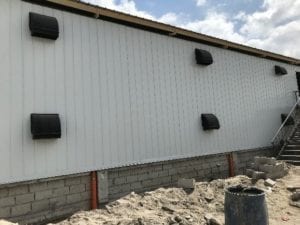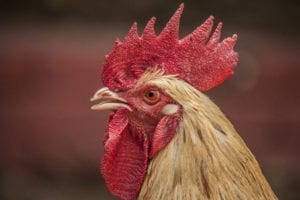ASPECTS OF LIGHT FOR POULTRY PRODUCTION:
 Birds sense light via the eyes and via the pineal gland, and through deep encephalic photoreceptors in the hypothalamus. Therefore, their circadian rhythm is controlled by changes in day length and light intensity. Successful farmers use this to manipulate the environment to maximize productivity.
Birds sense light via the eyes and via the pineal gland, and through deep encephalic photoreceptors in the hypothalamus. Therefore, their circadian rhythm is controlled by changes in day length and light intensity. Successful farmers use this to manipulate the environment to maximize productivity.
Breeders:
Light stimulation is critical for achieving a successful breeder flock. Production is maximised by ensuring that the rearing phase is done at a low light intensity for a maximum of 7-9 hours per day (in closed houses). An ideal light intensity for this phase of production is 0.4 lux (0.04 foot candles). How do we achieve this?
Light ingress is primarily through cool pad/tunnel inlet areas, minimum vents, tunnel fans and poorly sealed housing. Light traps are used to block light from entering through the fan aperture and can be used for all inlets. We can calculate the amount of light reduction in the tunnel opening area.
Assuming an outside light intensity of 107,639 lux (10,000 Foot Candles) – the cool pad will restrict light at a 2,000: 1 ratio. In this scenario, the light intensity in the dog house will be 53 lux (5.00 Foot Candles). To achieve 0.4 lux, we need to include a light trap to further exclude light. There are two common spacings of light traps – 1” or ¾” between vanes. 1” vanes reduce the light by 3,100,000: 1 and the ¾” vanes by 7,000,000: 1.
| OUTSIDE (full sunshine): 107,639 LUX 10,000 FC | |
| COOLPAD | |
| DOGHOUSE: 53.82 LUX, 5.O FC | |
| LIGHT TRAP ¾” VANE: | LIGHT TRAP 1” VANE |
| INSIDE HOUSE: 0.000008 LUX | INSIDE HOUSE: 0.000017 LUX |
Both these scenarios exceed the requirement to have 0.4 Lux, so it would be recommended to use the 1” vane as it would have less air restriction and be the less expensive option.
For the fan end of the building:
| OUTSIDE (full sunshine): 107,639 LUX 10,000 FC | |
| LIGHT TRAP ¾” VANE: | LIGHT TRAP 1” VANE |
| INSIDE HOUSE: 0.001 FC, 0.015 LUX | INSIDE HOUSE: 0.003 FC, 0.034 LUX |
It would be advisable in this situation too, that 1” vane light trap be chosen to achieve 0.4 Lux.
Persistency in lay can be highly influenced by changes in light intensity and duration during the laying period. In many countries closer to the equator, breeder growers commonly only use light traps until peak egg production. This is not recommended at higher latitudes as day lengths vary considerably throughout the year and can adversely affect post peak production if birds sense decreasing light intensity and duration.
Broilers:
 Since modern commercial poultry are mostly farmed indoors, birds are exposed to artificial lighting rather than natural daylight (free range chicken being the exception). Factors such as light intensity, photoperiod (light/dark cycles) and the type of light (eg LED) are all important.
Since modern commercial poultry are mostly farmed indoors, birds are exposed to artificial lighting rather than natural daylight (free range chicken being the exception). Factors such as light intensity, photoperiod (light/dark cycles) and the type of light (eg LED) are all important.
The eye differentiates different light wavelengths via retinal photoreceptors. Light of differing wavelengths can cause different stimulatory responses. Eg: Blue – calming; Red – feather pecking &/or cannibalism; Blue/Green – growth; Orange/Red – reproduction.
Modern lighting systems are changing rapidly from old style incandescent to compact fluorescent/sodium lamps to LED Solutions. LED are without doubt the most efficient energy-wise, environmentally friendly and have a close balance of light colours to mimic natural light.
Light has been used to stimulate appetite to increase daily weight gains for broilers. This is achieved by having multiple light/dark periods during a 24-hour period. This requires having a barn that can have low light intensities across the whole building. It is critical in these situations that there is sufficient light during the on times to allow the birds to access feed/water.
Appropriate lighting allows for adequate flock inspection, minimises activities that cause injurious behaviours, encourages optimal growth, provides sufficient rest periods for the birds, and supports normal eye development.
Adrian Hunting, VP International Sales
Subscribe to our blog!
